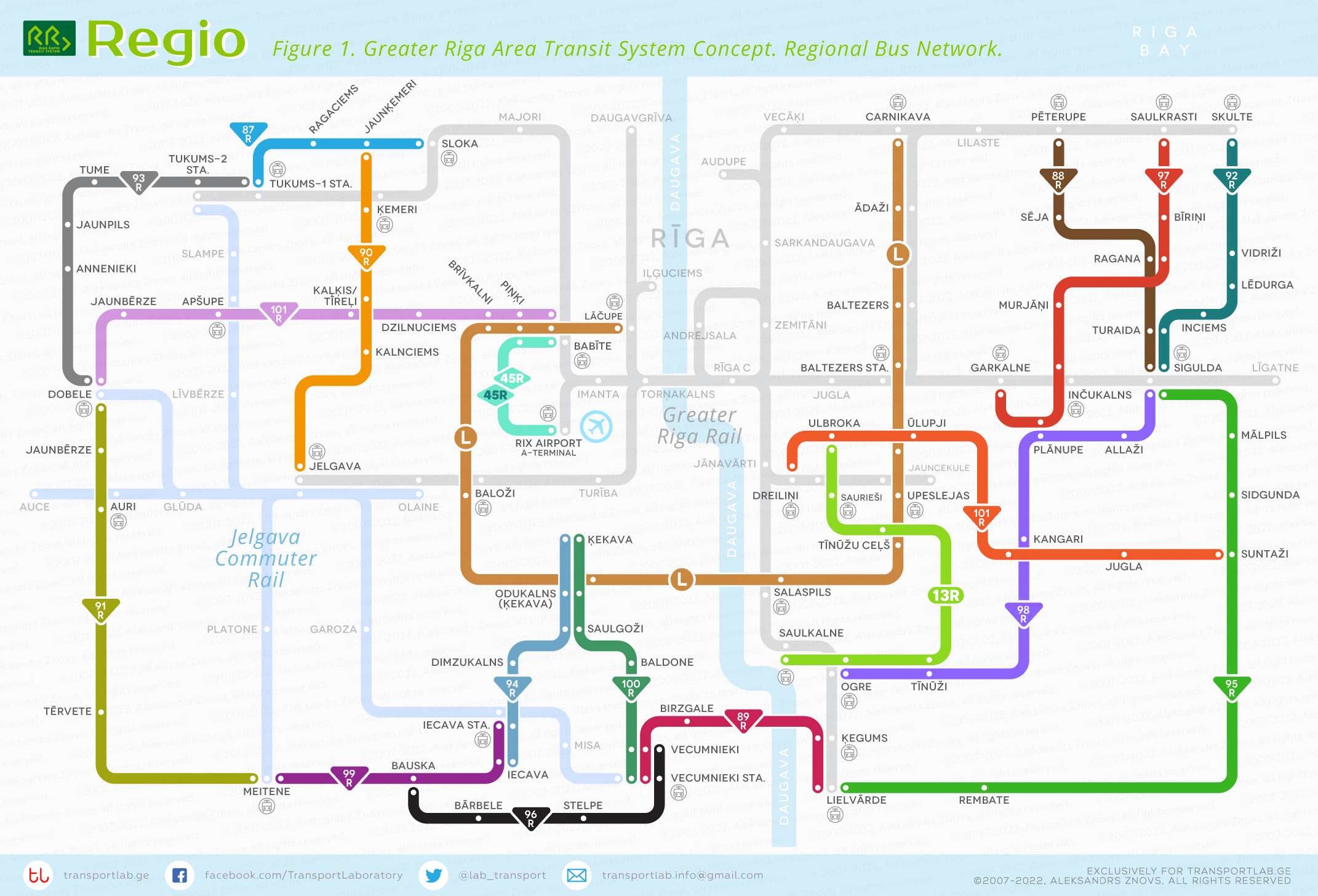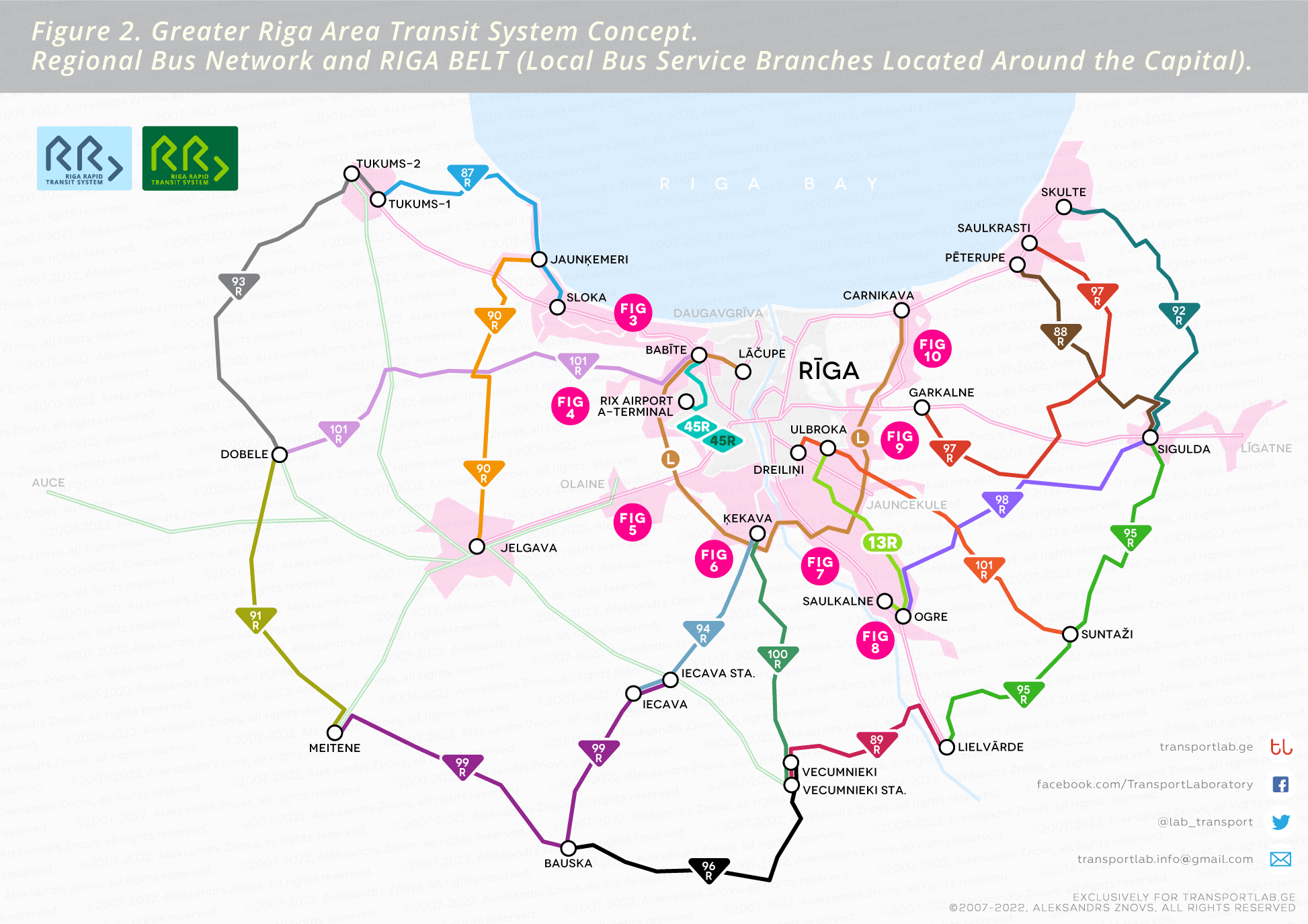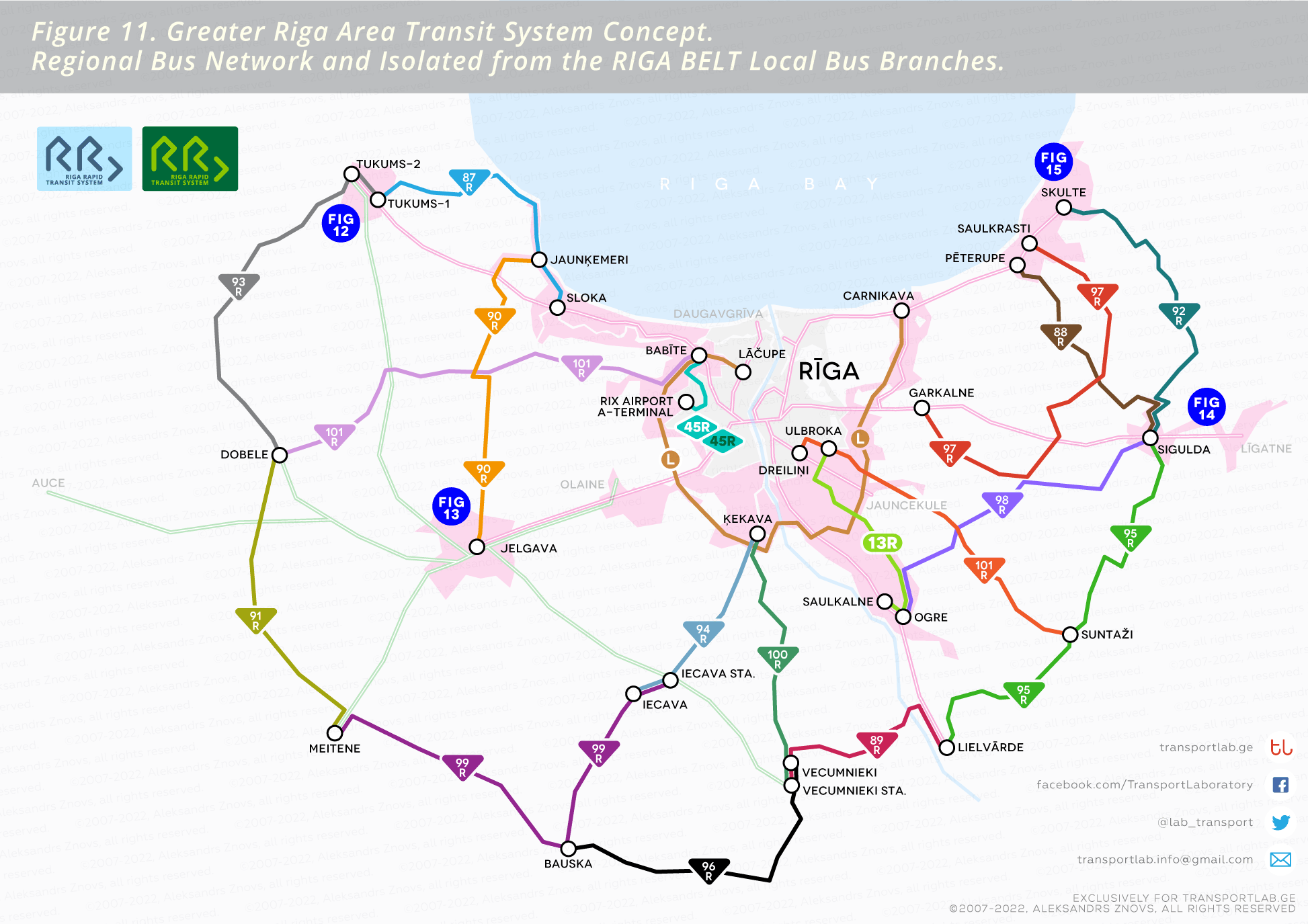I hope you remember the first part of my article where I considered the concept of the Greater Rīga Area railway network. The emphasis was on the rational use of the entire railway infrastructure. You can refresh the information here.
It is not difficult to understand: the railway cannot be everywhere – it is both costly and not impractical. Therefore, we can do nothing without such a common component as ordinary road transportation.
Ladies and gentlemen, to your attention, the second part of the article in which we will consider how the mass transit system of the Greater Rīga Area can be made as completely brilliant and undoubtedly efficient. The network of regional express trains and local transport routes are ready to help us.
Regional express bus network
The most important goal of my vision regarding regional bus lines is their efficiency, which is based on connecting some of the peripheral nodes of the Rīga suburban railway, replacing the train in some places where it is unprofitable to build railway branch lines. I was also guided by the principle that express buses should serve for the quick delivery of passengers from railway stations directly to nearby residential areas without additional stops in between.
Looking at the geographical map and the road net in the territory of interest, as well as assuming possible routes passenger flow, we got 19 routes (including the Line L, passing along the Rīga Bypass Road) and it looks like this:
As you can see, even this small number of express bus routes perfectly complements the railway lines and altogether forms a completely self-sufficient passenger network in the region. Of course, each of the routes can be changed, extended or combined with others.
What about the local transport?
Presumably, local transport can be left to the responsibility of local authorities. In this case, it will be fairly impossible to provide flexible, well-coordinated and highly comfortable passenger traffic and this noticeably worsens the satisfaction of passengers, which can adversely affect the popularity of the entire transit network.
In any project, all divisions must work like Swiss watches, so it is advisable to take control over the most important (i.e. significant passenger flow, strategically substantial area etc.) parts of the local passenger services closely connected with the regional transit network.
I am not going to focus on the Rīga municipal transport network, we will turn our views on local routes in the suburbs instead. Let’s take a look at the map below, on which residential areas closely adjacent to the borders of the capital are marked in pink. Right at first glance, you can see how the territory of settlements encircles the city of Rīga in a dense ring, literally without a gap. For the sake of simplicity, let’s call them the Small Belt (yes, there will be also the big one further). This “belt” consists of the following settlements (counterclockwise, not all are indicated on the map): Jūrmala, Babīte, Piņķi, Olaine, Baloži, Ķekava, Salaspils, Ikšķile, Ogre, Ulbroka, Berģi, Baltezers, Ādaži and Carnikava. Let’s divide the area into eight branches (vivid-pink circles with the corresponding numbers), where each is responsible for passengers moving on its territory and let’s ignore all administrative boundaries!
As you probably noticed, I spent a considerable amount of time researching, understanding and creating the route map sketches for each settlement, as well as finding names of settlements and stops as it would be an undeniable reality. Please note: route networks were created from scratch, regardless of existing routes. I suggest you familiarize yourself with the bus route map of each settlement below (to enlarge, click on the image, and then left-click to select an action. In the mobile version, please touch and hold):
JURMALA-13c
BABĪTE-JAUNMĀRUPE
OLAINE
ĶEKAVA-BALOŽI
SALASPILS-IKŠĶILE
OGRE
BERĢI
ĀDAŽI-CARNIKAVA
Previous
Next
Once again, I ask you not to forget these are just sketches so everything can be changed and improved, please do not dive in too deep to look for the mistakes. 😉
In addition to the above-described settlements, my concept covers much more territory than the neighbouring suburbs of the capital. There are several regional significance towns, which, of course, require a decent transport system and which should be integrated into the overall concept.
On the map below, you will see four blue circles with numbers – they indicate the four more remote towns that are not connected with the Small Belt by local bus lines. These are: Tukums, Jelgava, Sigulda and Saulkrasti. The rest smaller settlements I decided to ignore for now, since their imaginary 1-2 bus routes do not play a big role in the presentation. However, later they can be easily integrated.
Additionally, as promised I would like to pay your attention to the Big Belt I mentioned before. This is the outer ring of the whole transportation system fully consisting of regional bus service lines R87, R93, R91, R99, R96, R89, R95 and R92, connecting Sloka, Tukums, Dobele, Meitene, Bauska, Vecumnieki, Lielvārde, Suntaži, Sigulda and Skulte. The total length of this Big Belt is about 329 km. Same as RRTS Line L (86 km long) runs along the Small Belt, the Big Belt can be served by one superexpress line with very few stops in main towns if necessary.
The route diagrams of each of the abovementioned four towns are on the maps attached below.
TUKUMS
JELGAVA
SAULKRASTI-SKULTE
SIGULDA-LĪGATNE
Previous
Next
Well, now you have a complete picture of my vision regarding the transit system that can be organized on the territory of the Greater Rīga Area. To be strong and efficient, but cheap enough for passengers, small transport companies should unite and collectively build a large and convenient transit network for the residents of the whole region. A similar principle can be applied in other parts of the country. For example, in one of my previous articles, I have already proposed the concept of the Latgale railway network – it is perfectly possible to organize convenient regional and local communication around it. There are two more historical regions of Latvia – Kurzeme, which is located in the west of the country and Vidzeme, which is the northern part of Latvia. The same principle of decentralisation (I mean all in Latvia are rotating only around the capital) can be applied here as well. By now all we can do is to believe in a bright future and for the honesty and interest of officials on making at least anything for taxpayers who pay the salary to the “big guys”, by the way.
Please visit and like my page on Facebook where you can contact me in case of any question or claim mistakes found on my network maps. Hereby, you can follow me as well on Twitter to stay informed. Thanks.
Title image credit: Blake Martin













[…] large, detailed and juicy illustrated articles about this concept, so you can find them here and here. Please consider to check these articles for better understanding the whole concept. Except for the […]
[…] broad-gauge lines. To read about the other Latvia’s broad-gauge rail networks you can here, here, here and here. Now let’s take a more detailed look at my vision. I overlaid all my proposed […]